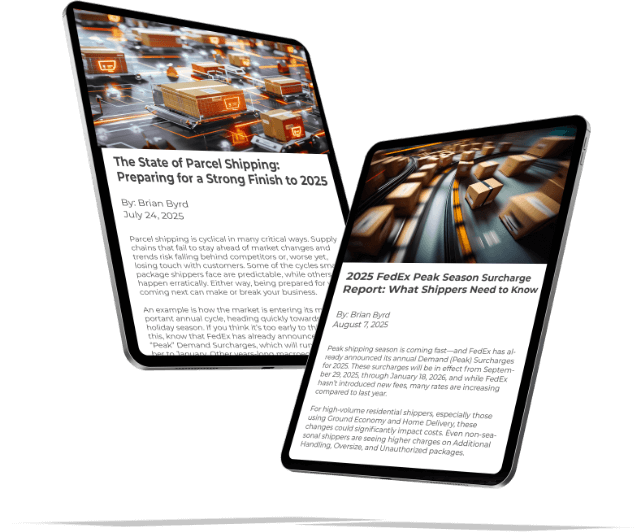OnTrac Announces 2025 Peak/ Demand and Other New Surcharges
OnTrac has announced 2025 Peak/Demand surcharges effective September 27 through ......

OnTrac has announced 2025 Peak/Demand surcharges effective September 27 through ......

Think you can keep up with UPS and FedEx rate changes in 2025? Good luck. This y......

Peak shipping season is coming fast—and FedEx has already announced its annual D......

FedEx has announced a mixed bag of rate changes impacting domestic and internati......

In today’s fast-paced environment, logistics performance isn’t just a supply cha......

At the most recent FedEx earnings call, CEO Raj Subramaniam made an important an......
Stay Up-to-Date with the Latest Carrier Announcements

Effective June 29, UPS has implemented a Surge Fee of $0.29 per lb. for shipment......

Shipping costs continue to rise in 2025—and it’s not just due to rate increases.......

Effective June 24, FedEx will implement a Demand Surcharge of $0.73 per lb. for ......

In today’s fast-paced e-commerce world—where customer expectations are rising an......

UPS announced a domestic fuel surcharge increase effective June 23, following th......

With peak shipping season just around the corner, it’s time for small parcel shi......

FedEx has announced a domestic and international fuel surcharge increase that wi......

FedEx has announced a new Demand Surcharge Fee on exports to Canada, effective J......

AI is everywhere—or so every software vendor would have you believe.

UPS recently announced several surcharge updates worth noting.

Parcel Shipping Costs continue to rise for parcel shippers, especially those mos......

The U.S. Postal Service has formally proposed raising shipping rates effective J......

One week after UPS announced an increase to its Additional Handling Surcharge (A......

UPS will implement a Surge Fee impacting shipments moving from the U.S. to Canad......

UPS has announced a new round of rate and surcharge updates that will take effec......

As e-commerce volumes surge and shipping activity grows more complex, so does th......

The ground economy services offered by UPS and FedEx have evolved significantly ......

FedEx will impose a demand surcharge on parcel shipments from China, Hong Kong, ......


Partnering with efficient carriers can reduce shipping costs. Many companies are......

After months of speculation, a large new piece of the tariff picture came into f......

The COVID-19 pandemic exposed vulnerabilities in global supply chains. Demand su......

Supply chains are the backbone of every successful business. In 2025, the way co......

Shipping costs directly affect your bottom line. Whether you’re running a small ......

The evolution of the parcel delivery market and the growth of ecommerce have bee......

Balancing customer demand while optimizing inventory levels can feel like a neve......

Accurate demand forecasting is one of the most critical elements of supply chain......

In today’s fast-paced and data-driven business environment, inventory management......

Launching a new product is exciting, but if your forecasting demand for new prod......

Parcel shipping fraud will result in your company paying more for shipping than ......

UPS has recently announced the implementation of several new fees and an increas......

Continuing with the final post of this 3-Part series… here’s how small parcel sh......

USPS has launched a new service: Priority Next Day. This new direct delivery ser......

UPS continues to implement off-cycle changes that increase costs for small parce......

Rising logistics costs make effective logistics cost reduction essential to prot......

Regional carriers and USPS smell opportunity in the marketplace, and their offer......

Frequent (and sometimes confusing) rate adjustments have become the norm for sma......

By adopting smarter Parcel Shipping Optimization strategies, you’ll protect your......

Predictive analytics in logistics industry has become a cornerstone of innovatio......

When UPS and FedEx first introduced dimensional weight (DIM) pricing for ground ......

Shipping expenses can consume as much as 15% of a company’s total revenue, but a......

Continuing our list from Part 1 (click here) of this 3-Part series… Here is Part......

Avoid The Fast-Growing Threat of Parcel Shipping Fraud to Maintain an Efficient ......

What is the one personal milestone that most of us resolve to reach every new ye......

Parcel invoice audit is essential because if you’re regularly shipping with UPS ......

This week in parcel, ocean freight rates climb amid troubles in the Red Sea, Fed......

For small parcel shippers who watch closely, there are several contradictions in......

FedEx is making several rate adjustments that will go into effect on February 10......

For all the complaints about UPS and FedEx rate increases and the constant drip ......

Every shipment is a gold mine of shipping data ! By using this information in th......

In this article, we will discuss various qualitative and quantitative forecastin......

Let’s dive into why safety stock optimization matters,

FedEx, one of the largest US parcel carriers and the largest US LTL carrier, ann......

OnTrac has announced a 5.7% General Rate Increase and increases to several surch......

With the 2025 GRIs announced (at a similar 5.9% by both carriers) and soon to be......

FedEx has announced that effective January 13, 2025 Additional Handling Surcharg......

Effective December 23, 2024, Small Business Rates for UPS Ground, UPS Air, and I......

UPS has announced a 5.9% General Rate Increase for 2025. The UPS GRI 2025 may fe......

Is ignorance bliss? If your goal is to remain unaware of the real impact of the ......

The headline from FedEx GRI 2025 is their rates are going up 5.9% next year. But......

The 2024 Peak Season Surcharge announcements from UPS and FedEx contain critical......

FedEx has announced its annual Demand (a.k.a. Peak) Surcharges that will be in p......

It’s almost that time of year. The upcoming GRI announcements are the biggest ne......

You’re likely aware that UPS kicked off 2024’s peak season early by announcing i......

The days of a company giving all its parcel volume to just one carrier are gone.......


Retail supply chain planning software has become critical for many organizations......

Imagine your supply chain as a giant orchestra and your products as symphonies. ......

Within the ever-changing supply chain management environment, decision-makers gr......